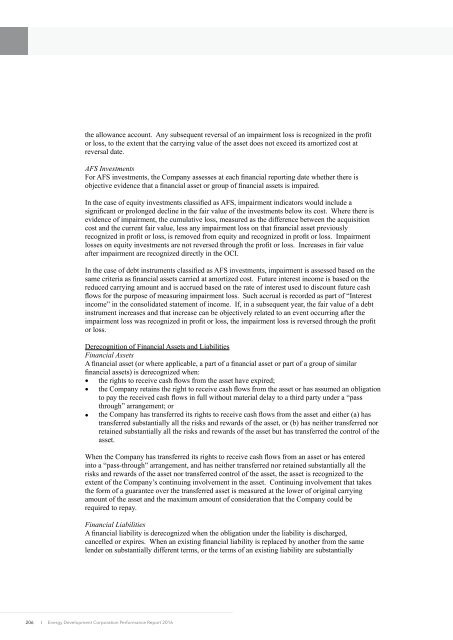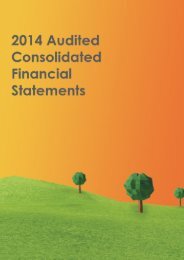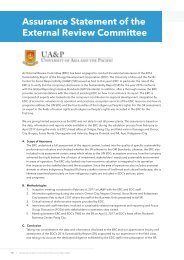EDC PR 2016 (FS section)
Create successful ePaper yourself
Turn your PDF publications into a flip-book with our unique Google optimized e-Paper software.
the allowance account. Any subsequent reversal of an impairment loss is recognized in the profit<br />
or loss, to the extent that the carrying value of the asset does not exceed its amortized cost at<br />
reversal date.<br />
A<strong>FS</strong> Investments<br />
For A<strong>FS</strong> investments, the Company assesses at each financial reporting date whether there is<br />
objective evidence that a financial asset or group of financial assets is impaired.<br />
In the case of equity investments classified as A<strong>FS</strong>, impairment indicators would include a<br />
significant or prolonged decline in the fair value of the investments below its cost. Where there is<br />
evidence of impairment, the cumulative loss, measured as the difference between the acquisition<br />
cost and the current fair value, less any impairment loss on that financial asset previously<br />
recognized in profit or loss, is removed from equity and recognized in profit or loss. Impairment<br />
losses on equity investments are not reversed through the profit or loss. Increases in fair value<br />
after impairment are recognized directly in the OCI.<br />
In the case of debt instruments classified as A<strong>FS</strong> investments, impairment is assessed based on the<br />
same criteria as financial assets carried at amortized cost. Future interest income is based on the<br />
reduced carrying amount and is accrued based on the rate of interest used to discount future cash<br />
flows for the purpose of measuring impairment loss. Such accrual is recorded as part of “Interest<br />
income” in the consolidated statement of income. If, in a subsequent year, the fair value of a debt<br />
instrument increases and that increase can be objectively related to an event occurring after the<br />
impairment loss was recognized in profit or loss, the impairment loss is reversed through the profit<br />
or loss.<br />
Derecognition of Financial Assets and Liabilities<br />
Financial Assets<br />
A financial asset (or where applicable, a part of a financial asset or part of a group of similar<br />
financial assets) is derecognized when:<br />
the rights to receive cash flows from the asset have expired;<br />
the Company retains the right to receive cash flows from the asset or has assumed an obligation<br />
to pay the received cash flows in full without material delay to a third party under a “pass<br />
through” arrangement; or<br />
the Company has transferred its rights to receive cash flows from the asset and either (a) has<br />
transferred substantially all the risks and rewards of the asset, or (b) has neither transferred nor<br />
retained substantially all the risks and rewards of the asset but has transferred the control of the<br />
asset.<br />
When the Company has transferred its rights to receive cash flows from an asset or has entered<br />
into a “pass-through” arrangement, and has neither transferred nor retained substantially all the<br />
risks and rewards of the asset nor transferred control of the asset, the asset is recognized to the<br />
extent of the Company’s continuing involvement in the asset. Continuing involvement that takes<br />
the form of a guarantee over the transferred asset is measured at the lower of original carrying<br />
amount of the asset and the maximum amount of consideration that the Company could be<br />
required to repay.<br />
Financial Liabilities<br />
A financial liability is derecognized when the obligation under the liability is discharged,<br />
cancelled or expires. When an existing financial liability is replaced by another from the same<br />
lender on substantially different terms, or the terms of an existing liability are substantially<br />
206<br />
I Energy Development Corporation Performance Report <strong>2016</strong>
















